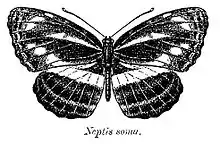Neptis soma
Neptis soma, the sullied sailer[1] or the creamy sailer,[2] is a species of nymphalid butterfly found in south and southeast Asia.[3][1]
| Sullied sailer | |
|---|---|
_Godavari.jpg.webp) | |
| Scientific classification | |
| Domain: | Eukaryota |
| Kingdom: | Animalia |
| Phylum: | Arthropoda |
| Class: | Insecta |
| Order: | Lepidoptera |
| Family: | Nymphalidae |
| Genus: | Neptis |
| Species: | N. soma |
| Binomial name | |
| Neptis soma | |
Description
Wet-season form

Males and females, upperside fuliginous black, with somewhat sullied white markings. Forewing: discoidal streak narrow, the apex truncate, triangular spot beyond narrow, very elongate; discal spots small, oval, all well separated; postdiscal transverse series of spots complete. Hindwing: subbasal band very narrow, slightly sinuous; discal and subterminal pale lines very obscure; postdiscal series of spots transverse, very narrow, often indicated only by a pale band.[4]
_at_Jayanti%252C_Duars%252C_WB_W_IMG_5423.jpg.webp)
Underside chocolate reddish brown, markings as on the upperside, but broader and slightly diffuse. Forewing with the discoidal streak and the triangular spot beyond it diffusely connate (united with others), some transverse linear white markings on either side of the postdiscal series of spots; the wing below vein 1 pale greyish brown. Hindwing: the discal and subterminal pale markings of the upperside represented by more clearly defined, very narrow, white bands, with, in the female, the addition of a terminal white similar band. Antennae black; head, thorax and abdomen fuliginous black; beneath dusky white.[4]
Dry-season form
_at_Jayanti%252C_Duars%252C_WB_W_IMG_5428.jpg.webp)
Males and females, upperside ground colour a more dusky fuliginous; the markings broader and slightly whiter, not sullied white. Underside: ground colour a shade brighter.[4][5]
Race kallaura, Moore. Of this form I have seen only a few specimens. Judging by the types, which are now in the collection of the British Museum, it differs less from the typical form than do any of the other races. As in N. soma, the markings are small and narrow; the subbasal band of the hindwing is, however, attenuated at each end, and not of even width, underside: ground colour very much paler and somewhat ochraceous, the anterior and posterior sets of spots of the discal series closer together respectively; the postdiscal band on the hindwing equal in width to the subbasal band. Recorded only so far from Travancore.[4]
Race hampsoni, Moore. Very closely allied to the typical form, but the markings pure white and broader in both seasonal forms, as in the race clinia. Upperside forewing: the spots of the discal series oval, outwardly rounded. Underside: ground colour dark ferruginous, the markings broad as on the upperside; the spots of the discal series, though closer to each other than in the typical form, still not connate, or forming an upper and lower band as in the race clinia. Recorded from the Nilgiris; Anaimalai Hills and Mysore.[4]
Subspecies
The subspecies of Neptis soma are:[1]
- N. s. soma - Nepal, northeast India
- N. s. ominicola - China
- N. s. tushita - Siam
- N. s. acala - Tonkin
- N. s. shania - Myanmar, Thailand, China
- N. s. somaoides - Kawi
- N. s. pendleburyi - peninsular Malaya
- N. s. tayalina - Taiwan
- N. s. butleri - Pakistan - Nepal
- N. s. shirozui - Taiwan
- N. s. palnica - south India[3][6]
Gallery
_at_Jayanti%252C_Duars%252C_WB_W_IMG_5429.jpg.webp) Dry-season form at Jayanti in Buxa Tiger Reserve in Jalpaiguri district of West Bengal
Dry-season form at Jayanti in Buxa Tiger Reserve in Jalpaiguri district of West Bengal Museum specimen from Malaya
Museum specimen from Malaya
References
- "Neptis Fabricius, 1807" at Markku Savela's Lepidoptera and Some Other Life Forms
- Kunte, K.; Sondhi, S.; Roy, P. "Neptis soma Moore, 1858 – Creamy Sailer". Butterflies of India. Indian Foundation for Butterflies. Retrieved 12 December 2020.
- R.K., Varshney; Smetacek, Peter (2015). A Synoptic Catalogue of the Butterflies of India. New Delhi: Butterfly Research Centre, Bhimtal & Indinov Publishing, New Delhi. p. 193. doi:10.13140/RG.2.1.3966.2164. ISBN 978-81-929826-4-9.
-
 One or more of the preceding sentences incorporates text from this source, which is in the public domain: Bingham, Charles Thomas (1905). Fauna of British India. Butterflies Vol. 1. London, Taylor and Francis; Calcutta and Simla, Thacker, Spink, & Co.; [etc.,etc.] pp. 330–332.
One or more of the preceding sentences incorporates text from this source, which is in the public domain: Bingham, Charles Thomas (1905). Fauna of British India. Butterflies Vol. 1. London, Taylor and Francis; Calcutta and Simla, Thacker, Spink, & Co.; [etc.,etc.] pp. 330–332. -
 One or more of the preceding sentences incorporates text from this source, which is in the public domain: Moore, Frederic (1896–1899). Lepidoptera Indica. Vol. III. London: Lovell Reeve and Co. pp. 241–243.
One or more of the preceding sentences incorporates text from this source, which is in the public domain: Moore, Frederic (1896–1899). Lepidoptera Indica. Vol. III. London: Lovell Reeve and Co. pp. 241–243. - Eliot, J. N. (1969). "An analysis of the Eurasian and Australian Neptini (Lepidoptera: Nymphalidae)". Bull. Br. Mus. (Nat. Hist.) Entomol. Suppl.15: 72–73. Retrieved 28 April 2018.